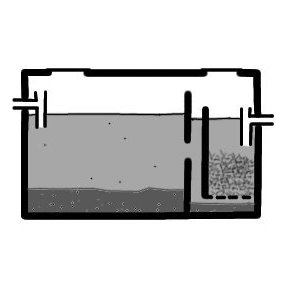المُلخص التنفيذي
An anaerobic filter is a fixed-bed biological reactor with one or more filtration chambers in series. As wastewater flows through the filter, particles are trapped and organic matter is degraded by the active biomass that is attached to the surface of the filter material. Anaerobic filters are widely used as secondary treatment in household black- or greywater systems and improve the solid removal compared to septic tanks or anaerobic baffled reactors. Since anaerobic filters work by anaerobic digestion, they can be designed as anaerobic digesters to recover the produced biogas.
| المُدخلات | المُخرَجات |
|---|---|
Fertigation Water, Biogas, Compost/Biosolids |
Introduction
Anaerobic filters are used as secondary treatment step in household greywater or blackwater treatment systems. They are also used, together with other treatment units in a so-called decentralised wastewater treatment system (DEWATS) (e.g. for biodegradable industrial wastewater).
An anaerobic filter is an attached biofilm system (fixed bed or fixed film reactor, see also fixed film activated sludge) that aims at removing non-settleable and dissolved solids (MOREL & DIENER 2006). As septic tanks or anaerobic baffled reactors, anaerobic filters are based on the combination of a physical treatment (settling) and a biological treatment (see also anaerobic digestion). It comprises a watertight tank containing several layers of submerged media, which provide surface area for bacteria to settle. As the wastewater flows through the filter usually from bottom to top (up-flow), it comes into contact with the biomass on the filter and is subjected to anaerobic degradation (MOREL & DIENER 2006).
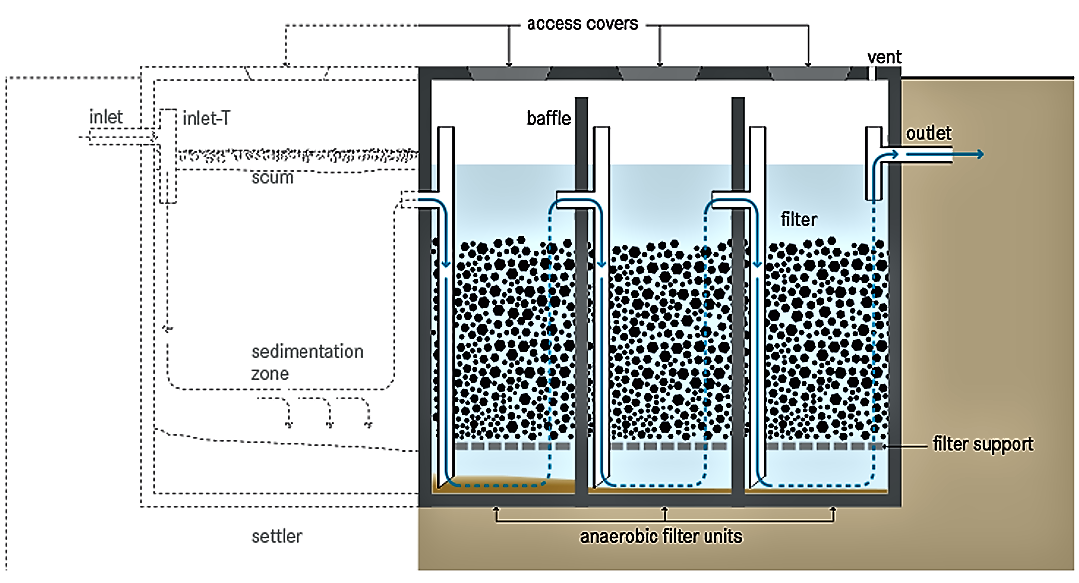
Anaerobic filters are used for wastewater with a low percentage of suspended solids and narrow COD/BOD ratio. It is suitable for domestic wastewaters and all industrial wastewater, which has a lower content of suspended solids. Pre-treatment in settlers or septic tanks may be necessary to eliminate solids of larger size before they are allowed to enter the filter (SASSE 1998). Recovering biogas may be considered in case of a BOD concentration >1,000 mg/L (SASSE 1998).
With this technology, suspended solids and BOD removal can be as high as 90%, but is typically between 50% and 80%. Nitrogen removal is limited and normally does not exceed 15% in terms of total nitrogen (TN). Total Coliform reduction is 1 to 2 log units (MOREL & DIENER 2006). The hydraulic retention time (HRT) compared to the tank volume should be in the range of 1.5 and 2 days for pre-settled blackwater (SASSE 1998) and 0.7 to 1.5 days for greywater (MOREL & DIENER 2006). For domestic wastewater, the constructed anaerobic filter volume (voids plus filter mass) may be estimated at 0.5 m3 /capita, for smaller units it may come to 1 m3 /capita (SASSE 1998).
Treatment Process
The construction of anaerobic filters is similar to septic tanks but generally there are several chambers and additional baffels in order to ensure upflow. Consequently, non-settleable and dissolved solids are also treated as they are brought into close contact with the active bacterial mass fixed on the filter material. The bacteria tend to fix themselves on reactor walls and filter material (e.g. gravel, rocks, cinder or specially formed plastic pieces) and anaerobically digests the dispersed or dissolved organic matter within short retention times. The larger the surface for bacterial growth, the quicker the digestion. A good filter material provides 90 to 300 m2 surface area per m3 of occupied reactor volume (SASSE 1998; MOREL 2006). A rough surface provides a larger area, at least in the starting phase. Later on, the biofilm that grows on the filter mass quickly closes the smaller groves and holes (SASSE 1998). The digestion process itself is similar to the one taking place in ABRs, but in ABRs the contact of the solids and the bacteria is provided by discharging wastewater to the bottom directly into the biomass, which is settled in the sludge.
Design Considerations
Pre- and primary treatment is essential to remove solids and garbage that may clog the filter. The majority of settleable solids are removed in a sedimentation chamber in front of the anaerobic filter. Small-scale stand-alone units typically have an integrated settling compartment, but primary sedimentation can also take place in a separate Settler or another preceding technology (e.g., existing Septic Tanks). Designs without a settling compartment are of particular interest for (Semi-) Centralized Treatment plants that combine the anaerobic filter with other technologies, such as the Anaerobic Baffled Reactor (ABR).
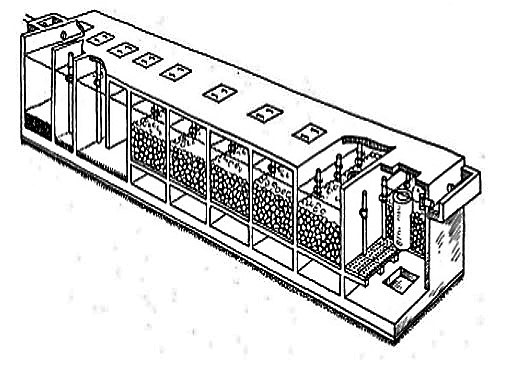
Anaerobic filters are usually operated in upflow mode because there is less risk that the fixed biomass will be washed out (SASSE 1998). In down flow systems flushing of the filter for the purpose of cleaning is easier. A combination of up-flow and down-flow chambers is also possible (SASSE. 1998). Anaerobic upflow filters with rock-filled beds, with a similar appearance as aerobic trickling filters are today promoted and commercialised as decentralised, on-site wastewater collection and treatment systems; simple to construct and to operate (ROSE 1997) . The water level should cover the filter media by at least 0.3 m to guarantee an even flow regime (MOREL & DIENER 2006) . The hydraulic retention time (HRT) is the most important design parameter influencing filter performance. An HRT of 12 to 36 hours is recommended.
The ideal filter should have a large surface area for bacteria to grow, with pores large enough to prevent clogging. The surface area ensures increased contact between the organic matter and the attached biomass that effectively degrades it. Ideally, the material should provide between 90 to 300 m2 of surface area per m3 of occupied reactor volume (SASSE 1998; MOREL 2006) . Typical filter material sizes range from 12 to 55 mm in diameter and decreases from bottom to top . Materials commonly used include gravel, crushed rocks or bricks, cinder, pumice, or specially formed plastic pieces, depending on local availability. Filters with two to three filter layers and a minimum depth of 0.8 to 1.2 m are recommended (SPERLING & CHERNICHARO 2005). Generally, simple anaerobic filters start with a first layer of large-sized cinder or rocks (5 to 15 cm), which are bedded on a perforated concrete slab about half a meter above ground parallel to the flow direction (SASSE 1998).
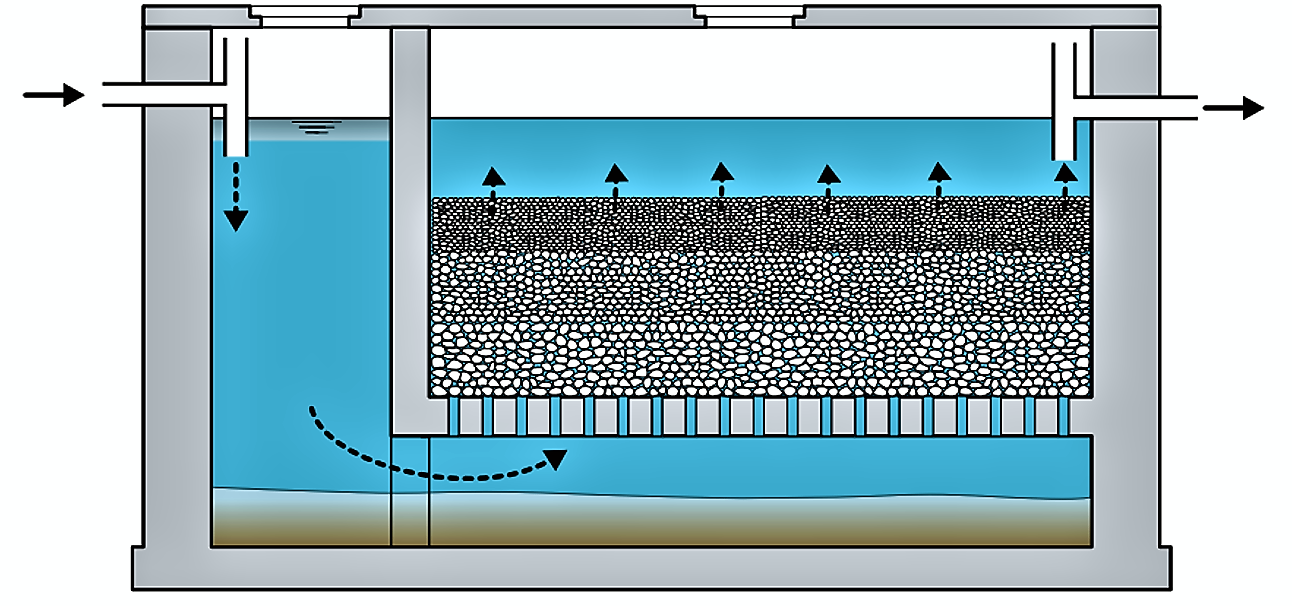
The connection between the chambers can be designed either with vertical pipes or baffles. Accessibility to all chambers (through access ports) is necessary for maintenance. The tank should be vented to allow for controlled release of odorous and potentially harmful gases.
The quality of treatment in well-operated anaerobic filters has been reported to be in the range of 50 to 90% BOD removal depending on the influent (SASSE 1998; MOREL & DIENER 2006). Total Suspended Solids (TSS) removal can be 50 to 80%; total nitrogen can be removed up to 15% and total Coliform reduction is 1 to 2 log units (MOREL & DIENER 2006). The hydraulic retention time (HRT) compared to the tank volume should be in the range of 1.5 and 2 days for pre-settled blackwater (SASSE 1998) and 0.7 to 1.5 days for greywater (MOREL & DIENER 2006). For domestic wastewater, the constructed anaerobic filter volume (voids plus filter mass) may be estimated at 0.5 m3 /capita, for smaller units it may come to 1 m3 /capita (SASSE 1998).
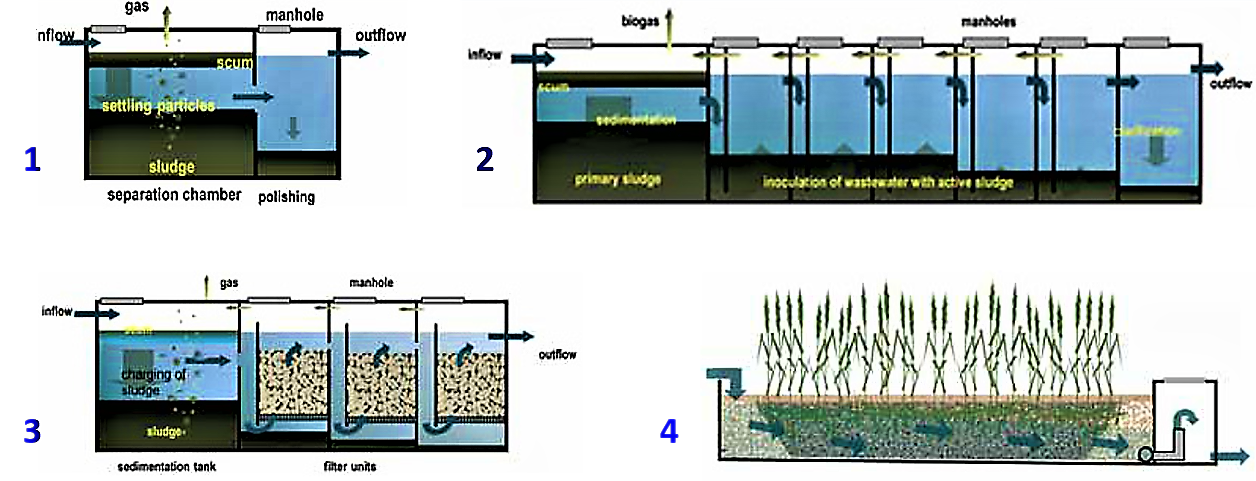
Depending on land availability and the hydraulic gradient of the sewer, the anaerobic filter can be built above or below ground (TILLEY et al. 2008). However, most often they are below the ground surface to save space, to reduce health risks and to provide insulation and protection against cold climates. However, access to inlet and outlet should be provided to allow regular checking of the state of the biofilm and the volume of accumulated sludge.
To prevent pollution of the groundwater, anaerobic filters should be watertight but they should still not be constructed in areas with high groundwater tables or prone to flooding. To prevent the release of potentially harmful gases, the anaerobic filters should be vented (TILLEY et al. 2008).
Health Aspects/Acceptance
Under normal operating conditions, users do not come in contact with the influent or effluent. Effluent, scum and sludge must be handled with care as they contain high levels of pathogenic organisms. The effluent contains odorous compounds that may have to be removed in a further polishing step. The effluent still contains pathogens and should be treated further if reused in agriculture (e.g. in a waste stabilisation pond system or a surface, horizontal or vertical flow constructed wetland), directly used for fertigation or discharged properly (e.g. in a leach field or soak pit). Care should be taken to design and locate the facility such that odours do not bother community members.
Costs considerations
The reactor vessel of anaerobic filters can be integrated in or is very similar to a septic tank and can be constructed at relatively low cost with locally available material. Filter material can be simple gravel, rocks, cinder or specially formed plastic pieces depending on the availability and the financial means. Pre-fabricated plastic or fibreglass tanks may also be available and may be less costly, depending on the context. Desludging is required regularly, preferably with a vacuum tanker. However, anaerobic filters still remain a rather low cost option (not really more expensive than septic tanks) for an acceptable treatment efficiency of dissolved compounds and some pathogens.
Operation & Maintenance
An anaerobic filter requires a start-up period of 6 to 9 months to reach full treatment capacity since the slow growing anaerobic biomass first needs to be established on the filter media. To reduce start-up time, the filter can be inoculated with anaerobic bacteria, e.g., by spraying septic tank sludge onto the filter material (SASSE 1998) . The flow should be gradually increased over time. It can be helpful to start first with lower hydraulic loads (e.g. 1/4 of the future daily flow, SASSE 1998) and then to increase the flow rate slowly over the following three months. Because of the delicate ecology, care should be taken not to discharge harsh chemicals into the anaerobic filter.
Scum and sludge levels need to be monitored to ensure that the tank is functioning well. Over time, solids will clog the pores of the filter. As well, the growing bacterial mass will become too thick, break off and eventually clog pores. When the efficiency decreases, the filter must be cleaned. This is done by running the system in reverse mode (backwashing) or by removing and cleaning the filter material (SASSE 1998; MOREL & DIENER 2006) . As with septic tanks, desludging of the primary settling chamber should be done at regular intervals. Both, desludging and cleaning of the filter material can be a health-hazard and appropriate safety precautions should be taken (TILLEY et al. 2008).
Anaerobic filters produce biogas. If it is not recovered, which is recommendable, there should be venting to evacuate the gases, but precaution should be taken for foul odours in densely populated areas.
Anaerobic filter tanks should be checked from time to time to ensure that they are watertight.
At a Glance
| Working Principle | Dissolved and non-settleable solids are removed by anaerobic digestion through close contact with bacteria attached to the filter media |
| Capacity/Adequacy | Household and community level; as secondary treatment step after primary treatment in a septic tank or an anaerobic baffled reactor; effluents can be infiltrated into soil or reused for irrigation; not adapted if high ground-water table or in areas prone to flooding. |
| Performance | BOD: 50 to 90%; TSS: 50 to 80 %; Total Coliforms: 1 to 2 log units |
| Costs | Generally low-cost; depending on availability of materials and frequency of back flushing and desludging. |
| Self-help Compatibility | Requires expert design, but can be constructed with locally available material. |
| O&M | Regularly backflush to prevent clogging (without washing out the biofilm); desludging of the primary settling chambers; needs to be vented if biogas not recovered. |
| Reliability | Reliable if construction is watertight and influent is primary settled; Generally good resistance to shock loading. |
| Main strength | Resistant to shock loading; High reduction of BOD and TSS. |
| Main weakness | Long start-up phase. |
This technology is easily adaptable and can be applied at the household level, in small neighbourhoods or even in bigger catchment areas. It is most appropriate where a relatively constant amount of blackwater (after a primary treatment (e.g. septic tank)) and greywater or industrial wastewater (with a lower suspended solid content) is generated. The anaerobic filter can be used for secondary treatment, to reduce the organic loading rate for a subsequent aerobic treatment step, or for polishing.
This technology is suitable for areas where land may be limited since the tank is most commonly installed underground and requires a small area. An anaerobic filter can be designed for a single house or a group of houses. It is only appropriate if water use is high, ensuring that the supply of wastewater is constant. Accessibility by vacuum truck is important for desludging. Anaerobic up-flow filters are also used as secondary treatment to lower septic tank effluent BOD and TSS concentrations prior to discharge to the subsurface wastewater infiltration system (U.S. EPA 2002). The anaerobic filter vessels should be watertight but it should still not be constructed in areas with high groundwater tables or prone to flooding. Depending on land availability and the hydraulic gradients of the connection pipes, the anaerobic filter can be built above or below ground (TILLEY et al. 2008).
Anaerobic filters can be installed in every type of climate, although the efficiency is lower in colder climates (TILLEY et al. 2014) . They are not efficient at removing nutrients and pathogens. Depending on the filter material, however, complete removal of worm eggs may be achieved. The effluent usually requires further treatment.
DEWATS / Decentralized Wastewater Treatment
The website of BORDA explains what DEWATs are, describes why DEWATS are necessary, shows good practices for hospitals, agroindustries and communities and lists benefits of decentralized wastewater treatment.
BORDA (2014): DEWATS / Decentralized Wastewater Treatment. Bremen: Bremen Overseas Research and Development Association (BORDA) URL [Accessed: 31.05.2019]Greywater Management in Low and Middle-Income Countries, Review of Different Treatment Systems for Households or Neighbourhoods
This report compiles international experience in greywater management on household and neighbourhood level in low and middle-income countries. The documented systems, which vary significantly in terms of complexity, performance and costs, range from simple systems for single-house applications (e.g. local infiltration or garden irrigation) to rather complex treatment trains for neighbourhoods (e.g. series of vertical and horizontal-flow planted soil filters).
MOREL, A. DIENER, S. (2006): Greywater Management in Low and Middle-Income Countries, Review of Different Treatment Systems for Households or Neighbourhoods. (= SANDEC Report No. 14/06 ). Duebendorf: Swiss Federal Institute of Aquatic Science (EAWAG), Department of Water and Sanitation in Developing Countries (SANDEC) URL [Accessed: 27.05.2019]Community-Based Technologies for Domestic Wastewater Treatment and Reuse- options for urban agriculture
The report suggests that emerging trends in low-cost, decentralised naturally-based infrastructure and urban wastewater management which promote the recovery and reuse of wastewater resources are increasingly relevant. Technologies for these sanitation options are presented. The concept of managing urban wastewater flows at a decentralised or "intermediate" level, based on micro watersheds, is explored. Effluent treatment standards that are currently accepted in order to protect public health and safety are reviewed.
ROSE, D.G. (1999): Community-Based Technologies for Domestic Wastewater Treatment and Reuse- options for urban agriculture. (= Cities Feeding People (CFP) Report Series. , 27 ). Ottawa: International Development Research Center Canada (IDRC) URL [Accessed: 23.05.2018]Informed Choice Catalogue
This informed choice catalogue for community based wastewater treatment technologies helps to identify suitable sanitation options and facilitates the assessment of different sanitation system components with regard to stakeholder preferences. A powerful tool for technical bottom-up planning giving overall information about technical options at a "glance".
SANIMAS (2005): Informed Choice Catalogue. pdf presentation. BORDA and USAID URL [Accessed: 29.05.2019]DEWATS
Exhaustive report on technological, operational and economic aspects of decentralised waste water treatment systems. Spreadsheet examples support the reader in designing and planning waste water treatment systems components.
SASSE, L. BORDA (1998): DEWATS. Decentralised Wastewater Treatment in Developing Countries. Bremen: Bremen Overseas Research and Development Association (BORDA) URL [Accessed: 03.06.2019]Biological Wastewater Treatment in Warm Climate Regions Volume 1
Biological Wastewater Treatment in Warm Climate Regions gives a state-of-the-art presentation of the science and technology of biological wastewater treatment, particularly domestic sewage. The book covers the main treatment processes used worldwide with wastewater treatment in warm climate regions given a particular emphasis where simple, affordable and sustainable solutions are required. The 55 chapters are divided into 7 parts over two volumes: Volume One: (1) Introduction to wastewater characteristics, treatment and disposal; (2) Basic principles of wastewater treatment; (3) Stabilisation ponds; (4) Anaerobic reactors; Volume Two (also available in the SSWM library): (5) Activated sludge; (6) Aerobic biofilm reactors; (7) Sludge treatment and disposal.
SPERLING, M. von LEMOS CHERNICHARO, C.A. de (2005): Biological Wastewater Treatment in Warm Climate Regions Volume 1. London: International Water Association (IWA) Publishing URL [Accessed: 26.05.2019]Compendium of Sanitation Systems and Technologies. 2nd Revised Edition
This compendium gives a systematic overview on different sanitation systems and technologies and describes a wide range of available low-cost sanitation technologies.
TILLEY, E., ULRICH L., LÜTHI, C., REYMOND P. and ZURBRÜGG C. (2014): Compendium of Sanitation Systems and Technologies. 2nd Revised Edition. Duebendorf, Switzerland: Swiss Federal Institute of Aquatic Science and Technology (Eawag) URL [Accessed: 03.05.2023] PDFCompendium of Sanitation Systems and Technologies
This compendium gives a systematic overview on different sanitation systems and technologies and describes a wide range of available low-cost sanitation technologies.
TILLEY, E., LUETHI, C., MOREL, A., ZURBRUEGG, C. and SCHERTENLEIB, R. (2008): Compendium of Sanitation Systems and Technologies. Duebendorf, Switzerland: Swiss Federal Institute of Aquatic Science and Technology (EAWAG) and Water Supply and Sanitation Collaborative Council (WSSCC) URL [Accessed: 15.02.2010] PDFOnsite Wastewater Treatment Systems Manual Technology Fact Sheet 5. Fixed-Film Processes
Technical factsheet on aerobic fixed-film processes (trickling filters and rotating biological contactors). Applications, main design assumptions, performance and maintenance are discussed.
U.S.EPA (2002): Onsite Wastewater Treatment Systems Manual Technology Fact Sheet 5. Fixed-Film Processes. المُدخلات: U.S.EPA (1980): Onsite Wastewater Treatment Systems Manual. 008.Compendium of Sanitation Systems and Technologies (Arabic)
This is the Arabic version of the Compendium of Sanitation Systems and Technologies. The Compendium gives a systematic overview on different sanitation systems and technologies and describes a wide range of available low-cost sanitation technologies.
TILLEY, E. ULRICH, L. LUETHI, C. REYMOND, P. SCHERTENLEIB, R. ZURBRUEGG, C. (2014): Compendium of Sanitation Systems and Technologies (Arabic). 2nd Revised Edition. Duebendorf, Switzerland: Swiss Federal Institute of Aquatic Science and Technology (Eawag) PDFOnsite Wastewater Treatment Systems Manual
Rather old design manual for onsite wastewater treatment options. However, valuable information on established systems such as septic tanks, sand filters, aerobic treatment units (suspended growth and fixed film), disinfection, nutrient removal as well as wastewater segregation and recycling are given. Additional information is given on disposal methods and appurtenances.
U.S.EPA (1980): Onsite Wastewater Treatment Systems Manual. (= EPA 625/1-80 , 12 ). United States Environmental Protection Agency, Office of Water Office of Research and DevelopmentGreywater Management in Low and Middle-Income Countries, Review of Different Treatment Systems for Households or Neighbourhoods
This report compiles international experience in greywater management on household and neighbourhood level in low and middle-income countries. The documented systems, which vary significantly in terms of complexity, performance and costs, range from simple systems for single-house applications (e.g. local infiltration or garden irrigation) to rather complex treatment trains for neighbourhoods (e.g. series of vertical and horizontal-flow planted soil filters).
MOREL, A. DIENER, S. (2006): Greywater Management in Low and Middle-Income Countries, Review of Different Treatment Systems for Households or Neighbourhoods. (= SANDEC Report No. 14/06 ). Duebendorf: Swiss Federal Institute of Aquatic Science (EAWAG), Department of Water and Sanitation in Developing Countries (SANDEC) URL [Accessed: 27.05.2019]DEWATS
Exhaustive report on technological, operational and economic aspects of decentralised waste water treatment systems. Spreadsheet examples support the reader in designing and planning waste water treatment systems components.
SASSE, L. BORDA (1998): DEWATS. Decentralised Wastewater Treatment in Developing Countries. Bremen: Bremen Overseas Research and Development Association (BORDA) URL [Accessed: 03.06.2019]Community-Based Technologies for Domestic Wastewater Treatment and Reuse- options for urban agriculture
The report suggests that emerging trends in low-cost, decentralised naturally-based infrastructure and urban wastewater management which promote the recovery and reuse of wastewater resources are increasingly relevant. Technologies for these sanitation options are presented. The concept of managing urban wastewater flows at a decentralised or "intermediate" level, based on micro watersheds, is explored. Effluent treatment standards that are currently accepted in order to protect public health and safety are reviewed.
ROSE, D.G. (1999): Community-Based Technologies for Domestic Wastewater Treatment and Reuse- options for urban agriculture. (= Cities Feeding People (CFP) Report Series. , 27 ). Ottawa: International Development Research Center Canada (IDRC) URL [Accessed: 23.05.2018]How to Select Appropriate Technical Solutions for Sanitation
The purpose of this guide is to assist local contracting authorities and their partners in identifying those sanitation technologies best suited to the different contexts that exist within their town. The first part of the guide contains a planning process and a set of criteria to be completed; these assist you in characterizing each area of intervention so that you are then in a position to identify the most appropriate technical solutions. The second part of the guide consists of technical factsheets which give a practical overview of the technical and economic characteristics, the operating principle and the pros and cons of the 29 sanitation technology options most commonly used in sub-Saharan Africa.
MONVOIS, J. GABERT, J. FRENOUX, C. GUILLAUME, M. (2010): How to Select Appropriate Technical Solutions for Sanitation. (= Six Methodological Guides for a Water and Sanitation Services' Development Strategy , 4 ). Cotonou and Paris: Partenariat pour le Développement Municipal (PDM) and Programme Solidarité Eau (pS-Eau) URL [Accessed: 19.10.2011]Anaerobic Reactors
Anaerobic Reactors is the forth volume in the series Biological Wastewater Treatment. The fundamentals of anaerobic treatment are presented in detail, including its applicability, microbiology, biochemistry and main reactor configurations. Two reactor types are analysed in more detail, namely anaerobic filters and especially UASB (upflow anaerobic sludge blanket) reactors. Particular attention is also devoted to the post-treatment of the effluents from the anaerobic reactors. The book presents in a clear and informative way the main concepts, working principles, expected removal efficiencies, design criteria, design examples, construction aspects and operational guidelines for anaerobic reactors.
LEMOS CHERNICHARO, C.A. de (2007): Anaerobic Reactors. (= Biological Wastewater Treatment Series , 4 ). London: International Water Association (IWA) Publishing. [Accessed: 01.11.2013]Biological Wastewater Treatment in Warm Climate Regions Volume 1
Biological Wastewater Treatment in Warm Climate Regions gives a state-of-the-art presentation of the science and technology of biological wastewater treatment, particularly domestic sewage. The book covers the main treatment processes used worldwide with wastewater treatment in warm climate regions given a particular emphasis where simple, affordable and sustainable solutions are required. The 55 chapters are divided into 7 parts over two volumes: Volume One: (1) Introduction to wastewater characteristics, treatment and disposal; (2) Basic principles of wastewater treatment; (3) Stabilisation ponds; (4) Anaerobic reactors; Volume Two (also available in the SSWM library): (5) Activated sludge; (6) Aerobic biofilm reactors; (7) Sludge treatment and disposal.
SPERLING, M. von LEMOS CHERNICHARO, C.A. de (2005): Biological Wastewater Treatment in Warm Climate Regions Volume 1. London: International Water Association (IWA) Publishing URL [Accessed: 26.05.2019]Compendium of Sanitation Systems and Technologies. 2nd Revised Edition
This compendium gives a systematic overview on different sanitation systems and technologies and describes a wide range of available low-cost sanitation technologies.
TILLEY, E., ULRICH L., LÜTHI, C., REYMOND P. and ZURBRÜGG C. (2014): Compendium of Sanitation Systems and Technologies. 2nd Revised Edition. Duebendorf, Switzerland: Swiss Federal Institute of Aquatic Science and Technology (Eawag) URL [Accessed: 03.05.2023] PDFGreywater Management in Low and Middle-Income Countries, Review of Different Treatment Systems for Households or Neighbourhoods
This report compiles international experience in greywater management on household and neighbourhood level in low and middle-income countries. The documented systems, which vary significantly in terms of complexity, performance and costs, range from simple systems for single-house applications (e.g. local infiltration or garden irrigation) to rather complex treatment trains for neighbourhoods (e.g. series of vertical and horizontal-flow planted soil filters).
MOREL, A. DIENER, S. (2006): Greywater Management in Low and Middle-Income Countries, Review of Different Treatment Systems for Households or Neighbourhoods. (= SANDEC Report No. 14/06 ). Duebendorf: Swiss Federal Institute of Aquatic Science (EAWAG), Department of Water and Sanitation in Developing Countries (SANDEC) URL [Accessed: 27.05.2019]Decentralised greywater reuse for irrigation in peri-urban areas
The International Development Research Centre (IDRC) provided financial assistance to an applied research project on greywater treatment and reuse for home garden irrigation in 25 low-income households in Ein Al Beida village, southern Jordan. The main objective was to help the peri-urban poor in Jordan preserve precious freshwater, achieve food security and generate income, while helping to protect the environment. An anaerobic vertical flow filter (AVF) and an anaerobic up-flow filter (AUF) were tested in parallel.
MOREL, A. DIENER, S. (2006): Decentralised greywater reuse for irrigation in peri-urban areas. Case study from Ein Al Beida, Jordan. المُدخلات: MOREL, A. ; DIENER, S. ; (2006): Greywater Management in Low and Middle-Income Countries, Review of Different Treatment Systems for Households or Neighbourhoods. Duebendorf: 69-72.Decentralised wastewater treatment – New Concepts and Technologies for Vietnamese Conditions
The authors describe results from experiments on treatment of domestic wastewater by baffled septic tanks with an anaerobic filter that could be a feasible option for on-site wastewater treatment in residential areas of Vietnam.
VIET ANH, N. DUC HA, T. HIEU NHUE, T. HEINSS, U. MOREL, A. MOURA, M. SCHERTENLEIB, R. (2003): Decentralised wastewater treatment – New Concepts and Technologies for Vietnamese Conditions . Luebeck: IWA and GTZDecentralized Wastewater Treatment System - DEWATS
The wastewater from Manjuyod’s public market is treated in a decentralized system (DEWATS) composed of four different components: a settling tank; a anaerobic baffled reactor which reduces the BOD/COD content from 20% to 85%; a planted gravel filter; and finally a polishing pond.
BORDA (2008): Decentralized Wastewater Treatment System - DEWATS. Manjuyod Public Market. (= Sustainable Sanitation – Project Data Sheet ). Bremen: Bremen Overseas Research and Development Association (BORDA) URL [Accessed: 26.03.2010]Decentralised Wastewater Treatment Methods for Developing Countries
Different operation and maintenance options are presented with respect to sustainable plant operation, the use of local resources, knowledge, and manpower.
NATURGERECHTE TECHNOLOGIEN, BAU- UND WIRTSCHAFTSBERATUNG (TBW) GmbH (2001): Decentralised Wastewater Treatment Methods for Developing Countries. GTZ and GATESanitation Systems and Technologies. Lecture Notes
Lecture notes on technical and non-technical aspects of sanitation systems in developing countries.
EAWAG/SANDEC (2008): Sanitation Systems and Technologies. Lecture Notes . (= Sandec Training Tool 1.0, Module 4 ). Duebendorf: Swiss Federal Institute of Aquatic Science (EAWAG), Department of Water and Sanitation in Developing Countries (SANDEC)Sanitation Systems and Technologies. Presentation
PDF presentation on the technical and non-technical aspects of sanitation systems in developing countries.
EAWAG/SANDEC (2008): Sanitation Systems and Technologies. Presentation. (= Sandec Training Tool 1.0, Module 4 ). Duebendorf: Swiss Federal Institute of Aquatic Science (Eawag), Department of Water and Sanitation in Developing Countries (Sandec)
